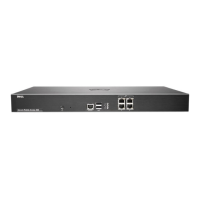Dell SonicWALL Secure Mobile Access 8.5
Administration Guide
163
When this field is configured, it redirects the user to the Web site’s home page the first time the user
accesses the portal. This happens only when the user is accessing the site with no URL path (that is,
when accessing the root folder, for example: https://www.google.com/). This is not an alias for the
root folder. The user can edit the URL to go back to the root folder.
The key=value pairs allow you to specify URL query parameters in the URL. You can use these for any
Web site that does not have a default redirect from the root folder to the home page URL. Outlook Web
Access is one example, but note that most public sites do have a default redirect.
11 Select a Proxy Host from the drop-down menu to provide the ability to select which host name is sent to
the backend server. Options include Inherited from client request, Virtual Hostname, and Application
Server Host (backend). The Inherited from client request option is the default value.
Security Settings
1 Under Security Settings, select the Enable Web Application Firewall button to enable the feature.
2Select Disable Access Policies to prevent existing Access Policies from taking precedence.
3 Select the Disable Authentication Controls, Access Policies, and CSRF Protection (if enabled)
check box if you need no authentication, access policies, or CSRF protection enforced. This is useful for
publicly hosted Web sites.
4 To configure ActiveSync authentication, clear the Disable Authentication Controls check box to display
the authentication fields. Select the Enable ActiveSync authentication check box and then type the
default domain name. The default domain name will not be used when the domain name is set in the
email client’s setting.
5 Select the Automatically Login check box to configure Single Sign-On settings.
6For Automatically log in using SSO, select one of the following radio buttons:
• Use SSL-VPN account credentials – allow login to the offloaded application using the
credentials configured on the SMA/SRA appliance
• Use custom credentials – displays Username, Password, and Domain fields where you can
enter the custom credentials for the application or use dynamic variables. For the Password
field, enter the custom password to be passed, or leave the field blank to pass the current user’s
password to the offloaded application portal. For the other fields, dynamic variables can be used,
such as those shown below:
7If you selected Automatically Log in, select the Forms-based Authentication check box to configure
Single Sign-On for forms-based authentication.
Table 26. Supported dynamic variables
Text Usage Variable Example Usage
Login Name %USERNAME% US\%USERNAME%
Domain Name %USERDOMAIN% %USERDOMAIN\%USERNAME%
Group Name %USERGROUP% %USERGROUP%\%USERNAME%

